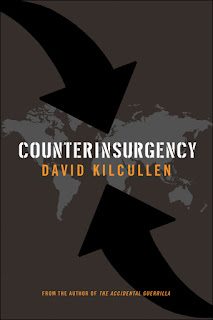Author: David Kilcullen
ISBN: 978-0-199-73749-9
Publisher: Oxford UP
Year: 2010
Softcover
Pages: 251
Photos/maps: 7/1
Those of you actively involved in counterinsurgency
operations are most likely to have heard about David Kilcullen. Both an
experienced operator (infantry in East Timor, Indonesia as well as tours in
Iraq and Afghanistan) as well as a renowned student of the insurgent/terrorism
‘art’ he has, in this book, put together a practical and common sense approach
to tackling the challenges of insurgency and terrorism (he clearly delineates
between the two) in different environments.
The book is a compilation of articles and concept papers that he has drafted
based on firsthand experience, immediate debriefs with those involved in
conflict, follow-on interviews with combatants from both sides as well as a
deep engagement with local civilians.
His first chapter covers the 28 articles or ‘rules of
thumb’ that a counterinsurgent must remember to maintain effectiveness. Based,
very loosely, as a companion piece to the
original 27 articles of TE Lawrence (of WW1 Arabic uprising fame), it is
updated and adjusted to reflect the realities of the modern counterinsurgent
battle space. Each article is also preceded by an explanatory introduction that
sets the stage for the focus of the article and provides for the reader the
context within which to approach it. His points are succinct and eminently
relevant and logical.
His next chapter discusses the value and merit of
metrics. He acknowledges the critical requirement of being able to measure
success (or failure); however, he posits that the traditional methods of
measurement are not relevant or accurate to the asymmetric conflicts that we
are engaged in. For example, the traditional body counts or military
accessibility levels into regions do not provide for accurate measurements of
enemy capability. Rather, he suggests that a series of non-traditional metrics
based upon the four ‘pillars’ of counterinsurgency (the population, the
supported government, the security forces and the enemy forces) should be
adopted. Examples that he provides are not exhaustive but do adjust the
paradigm of the reader into a more correct avenue. Things such as: price of
exotic vegetables, tax collection or participation in sponsored programs can
act as indicators for population stability, Government Indicators: where
officials sleep, capital flight, rate of budget execution; Security Forces:
ratio of guilty to innocent detainees, ratio of kills to wounds/captures, night
operations and, finally, Enemy Forces: Insurgents villages of origin, insurgent
medical health, price of black market guns and ammunition and midlevel
insurgent casualties.
In the following chapters he discusses the success of the
Indonesian forces in suppressing the West Java insurgents in the late 1950’s
and how the tactics used so successfully there were a failure when it came to
East Timor (and why). This chapter is extremely interesting as it reinforces
the importance of appreciating how there is no standard solution to an
insurgency that can be applied universally. Changes in motivation, geography
and technology (to name a few) can have profound effects upon the methodology
best suited to countering it. The Indonesian example is particularly relevant
when viewed from the perspective of the impact of world opinion on the
activities of Indonesian security forces in East Temor mirroring the of ‘media’
and communication technology as a factor (both positive and negative) on
operations.
He next discusses the environment within which
insurgencies are able to flourish. He postulates that identifying regions as
being pro-government or pro-insurgent is missing the fundamental truth that
populations seek security, predictability and stability and they will follow
whatever group or organization that can guarantee it locally. This is one of
the main reasons for the frustrating tendency in Afghanistan for locals to
‘switch’ from government to Taliban and back. It is not loyalty; it is
pragmatism that is their driving force. Thus it is that concurrent to an armed
challenge of an insurgency, it is imperative that issues of poor governance,
corruption and mismanagement amongst the governing body be addressed
aggressively.
He concludes with an examination of the modern phenomenon
of the global insurgency, its make-up, methods of operation, strengths and
weaknesses. Starting with an assessment
of the differences between ’terrorism’ (seen today as synonymous with any act
of violence against the government) and ‘insurgency’ he clearly delineates not
only the difference between two, but
also, the forces behind them and the paradigm shift needed to address them
effectively. He concludes with a discussion on the critical weaknesses of the
global jihadist style movements and how best to exploit these weakness in the
‘competition for government’.
Kilcullen has a great wealth of experience to draw upon
when contemplating these issues. There are those who would make the argument
that much of what he writes is common sense and not new revelations. That may
be; however, it is also true that while many of the successful techniques used
against jihadist movements have been used in the past, it took much blood and
treasure to begin applying the lessons of yesteryear. The shift in paradigm and
approach to the modern global jihadist with its access to instantaneous
communications requires not only a reinforcement of our previously learned but
forgotten lessons, but further enhancement
to meet the unique challenges of today’s modern insurgent. Kilcullen’s book is
an excellent place to further enhance that education.

No comments:
Post a Comment